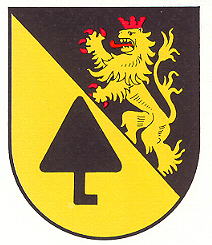Lohnweiler: Difference between revisions
Jump to navigation
Jump to search
Knorrepoes (talk | contribs) m (Text replacement - "/Arms of " to "/Arms (crest) of ") |
Knorrepoes (talk | contribs) m (Text replacement - "{{media}}" to " {{de1}} {{media1}}") |
||
| Line 24: | Line 24: | ||
The upper half shows the lion of the Pfalz, as the village historically was ruled by the Dukes of the Pfalz. The lower half shows the old village symbol, which can be seen on the old borderstones, dating from 1750, near the village. The tool is described as a canting Lohnen, which is either a tool, or a part of a wagon-wheel. | The upper half shows the lion of the Pfalz, as the village historically was ruled by the Dukes of the Pfalz. The lower half shows the old village symbol, which can be seen on the old borderstones, dating from 1750, near the village. The tool is described as a canting Lohnen, which is either a tool, or a part of a wagon-wheel. | ||
{{ | |||
{{de1}} | |||
{{media1}} | |||
[[Civic Heraldry Literature - Germany|'''Literature''']]: Debus, 1988 | [[Civic Heraldry Literature - Germany|'''Literature''']]: Debus, 1988 | ||
Revision as of 11:17, 26 December 2022
This page is part of the German heraldry portal |
Heraldry of the World |
|
German heraldry:
|
Selected collector's items from Germany:
|
LOHNWEILER
State : Rheinland-Pfalz
District (Kreis) : Kusel
Verbandsgemeinde : Verbandsgemeinde Lauterecken-Wolfstein (until 2014 Verbandsgemeinde Lauterecken)
Origin/meaning
The arms were granted on August 7, 1980.
The upper half shows the lion of the Pfalz, as the village historically was ruled by the Dukes of the Pfalz. The lower half shows the old village symbol, which can be seen on the old borderstones, dating from 1750, near the village. The tool is described as a canting Lohnen, which is either a tool, or a part of a wagon-wheel.
Literature: Debus, 1988


